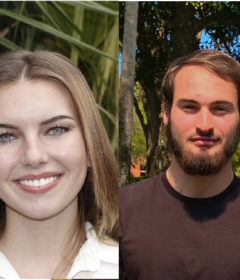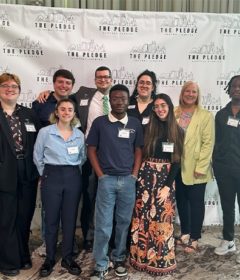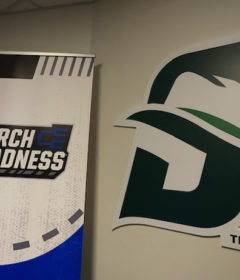AAUW Brings First Tech Trek to Stetson for Middle School Girls
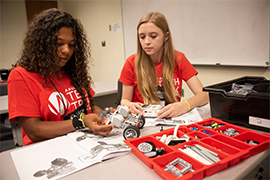
In a Sage Hall classroom on the Stetson campus, Isabella Edwards and Aun’Yale Howard, who both recently completed the seventh grade, were having problems with Bingo.
“Bingo doesn’t take directions very well,” Isabella said with a smile. “Bingo is a difficult child.”
Amy Monahan, their instructor, suggested the source of the problem: “When you changed the tires, it changed everything.”
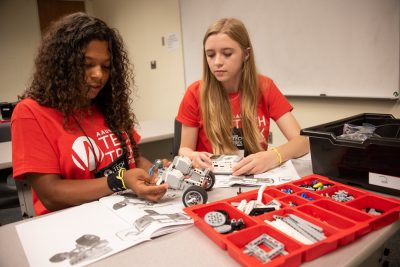
Aun’Yale, a student at Buddy Taylor Middle School in Palm Coast, and Isabella, a student at the Imagine School in North Port, went back to their laptop computer to recalibrate the program of the eight-inch, wheeled robot rover they had assembled from a rather sophisticated Lego kit – and which they named Bingo.
The 90-minute robotics workshop was just one of the activities engaging 48 recent seventh-grade girls from throughout Florida during the first AAUW Tech Trek program to be held at Stetson. The American Association of University Women, a nonprofit organization founded in 1881 to encourage women to pursue a college education, founded its Tech Trek summer camp in 1998 to expose girls to career possibilities in STEM (science, technology, engineering and math). Today the program is held at 22 sites around the nation.
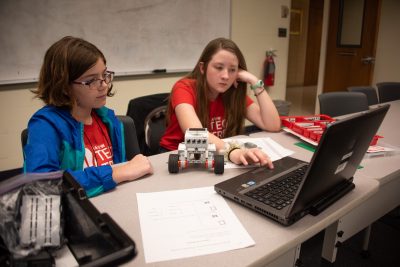
During the week-long residency program at Stetson, which concludes Saturday, June 15, students in groups of 12 take one of four, four-day core courses such as “All About Rockets” or “Chemistry Catalysts,” and they attend 90-minute workshops involving math, engineering, DNA science, physics, 3-D design and robotics.
The program also included a Professional Women’s Night on Wednesday, June 12, in the Stetson Room at the Carlton Union Building. Nine women who are in STEM careers or have STEM backgrounds dined at tables with the students, spoke about their careers and fielded questions. The mentors included Stetson President Wendy Libby, Ph.D.; Rosalie Richards, Ph.D., Associate Provost for Faculty Development and Professor of Chemistry and Education; and Roslyn Crowder, Ph.D., Assistant Professor of Biology.
The goal of Tech Trek “is to get more women in STEM since there’s a particular lack of women in STEM,” said Shawnrece Campbell, Ph.D., Associate Dean in the College of Arts & Sciences and one of the main organizers of Stetson’s Tech Trek.
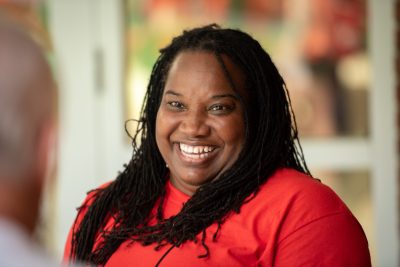
Middle school is a critical age for girls, Campbell said: “You want to capture them as they are preparing and thinking about high school so that they will continue to focus on STEM in high school and throughout college.”
The aauw.org website says middle school is “the age when girls’ participation in STEM fields statistically drops.”
Monahan, the robotics workshop instructor and the STEM specialist for Volusia County schools, said the all-girl camp provides an opportunity for female students to flourish.
“Research shows that when girls are working with just girls, they are apt to do more,” Monahan said. “When they’re in the schools, boys tend to take over, or the girls tend to be standoff-ish. Boys and girls do exactly the same thing in kindergarten through maybe third grade. That starts to change about fourth grade. They will change how they act in a group together. Girls tend to start backing out, which is why we have less girls in STEM.”
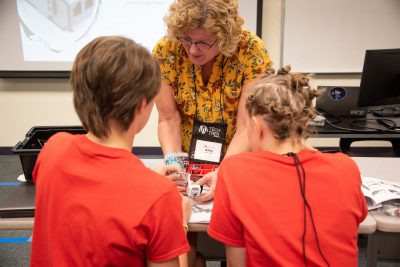
Tech Trek “is a way to say to girls ‘This your realm, this is important for you, and you can continue on and have a place’ in STEM,” Monahan said.
Students are selected through a competitive process that includes nomination by their middle school science, math or computer teachers. Student applicants must write a 500-word essay and undergo personal interviews with the AAUW branch in their area before a committee makes its choices.
Other than a $50 registration fee, participation for students is free – the $1,100 cost per camper is funded by the AAUW (even the registration fee may be waived in some cases).
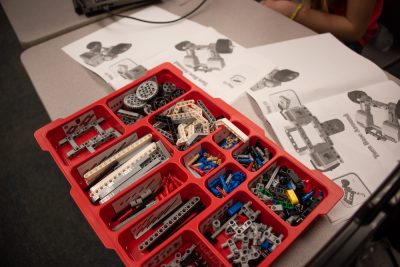
Courses and workshops are taught by middle school teachers recruited from Central Florida schools because they are familiar with teaching that grade level, Campbell said. All the instructors at the Stetson camp are female except for one civil engineering teacher from Jacksonville, who agreed to fill in at the last minute when another teacher had to pull out.
Learning continued outside of the classroom during Professional Women’s Night. President Libby, during her opening address at the dinner, held up a copy of The New York Times’ weekly science section.
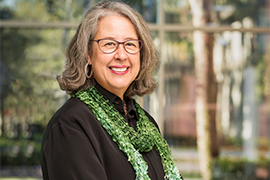
“I grew up in New York City and we lived in an apartment house,” she said. “When I was a kid, we couldn’t afford to get the New York Times. We would sneak over to the garbage room to pull it out of the garbage so we could read it. My favorite part is still the Tuesday science section.”
Libby earned her bachelor’s degree in biology and genetics from Cornell University “because I love science,” she said. “I still love science.”
Although Libby went on to earn an MBA in finance and a Ph.D. in education administration, “I have never forgotten what science taught me in terms of how you frame questions, how you look for answers and how you form solutions,” she said. “While I hope that every one of you finds a home in science or technology or math, you will never lose by following this as your primary education. You never know where life is going to take you, but your interest in the STEM fields may prepare you to be a college president someday. Who knows?”
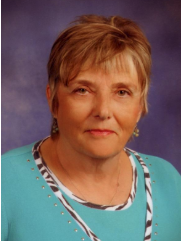
Pat Ross, president of AAUW Florida, addressed the audience at the Professional Women’s Night dinner and drew laughter when she noted one of the organization’s first research projects: “The AAUW was founded in 1881 by some women who wanted to encourage other women to get a college education, because very few women went to college back then. One of the first things we did was sponsor research that proved it would not affect your fertility if you went to college. Apparently that was a big issue back in the day.”
Ross moderated a panel discussion in which the mentors responded to questions from her, such as “What is a typical day for you?” and “How did you choose your career path?” Students posed such questions as “How do you empower women in your line of work?” and “What are some of the hardest obstacles you had to overcome?”
“The fact that you are 13 and 14 and you are having these kinds of questions is blowing my socks off,” said Richards, Stetson’s Associate Provost for Faculty Development.
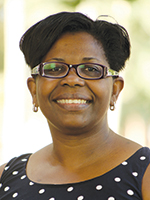
Ross concluded the panel discussion by asking the mentors: “If you could go back and talk to your 13-year-old self, what advice would you give her?”
Eva Loosier, Distribution Engineering Manager – Central East for Duke Energy, said, “I would tell myself to be more confident in who you are. Even through college and getting into the industry, I kept trying to be one of the boys. I’ve sat in rooms just this year for hurricane prep and there were 50 men and me. My last team was 22 men and me. It took me a long time to be confident as a woman . . . so just learn to be confident in who you are and the abilities you have.”
Sheryl Rogers, Behavior Specialist for the Department of Children and Families, recalled as a student that “counselors always tried to put me in home economics — cooking class — and I really wanted to take welding where you use the blowtorch, or wood shop where you’re cutting stuff. I wish I would have advocated more for myself as a student.”
Dr. Laressa Ferdinand-Dukes, an obstetrician and gynecologist, advised students to “don’t dumb yourself down. I know I was guilty of that at 13. At that age I knew I had certain talents, but I was too busy trying to be part of the crowd. Be able to stand behind your talents and your gifts and not be ashamed of them.”
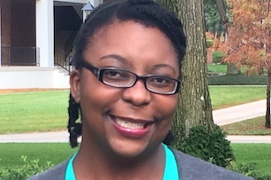
Crowder, the Stetson biology professor, reassured students: “I would say you don’t have to have it all figured out at that age. You can try some stuff and if you don’t like it, you can try other things. You can create your own path.”
Campbell, an AAUW member, said the inspiration to host Tech Trek at Stetson came from Carol Buckels, a long-time AAUW member and Director of Stetson’s Office of Grants, Sponsored Research and Strategic Initiatives.
Tech Trek will return to Stetson next year, Campbell added – the university has become the program’s first permanent host site in Florida. Previously the program, including a second Tech Trek held annually in South Florida, has been held at different locations.
— Rick de Yampert

